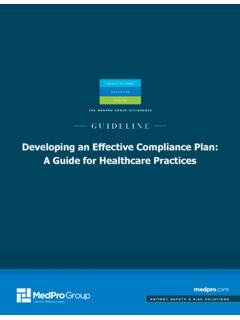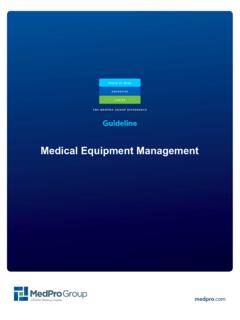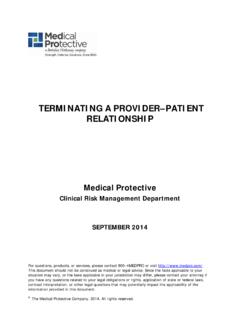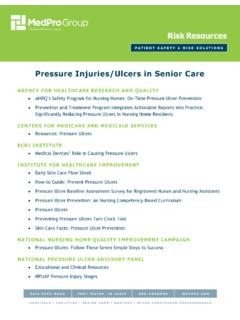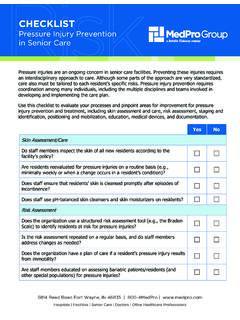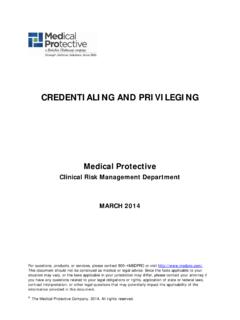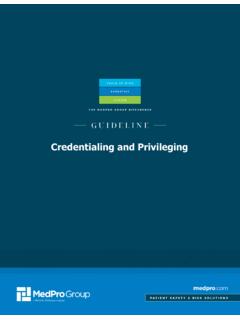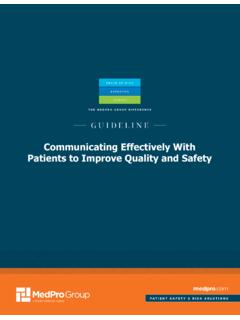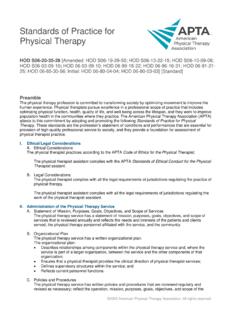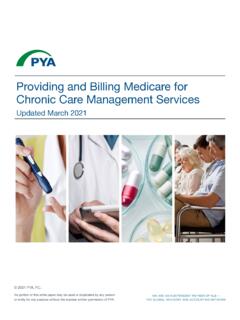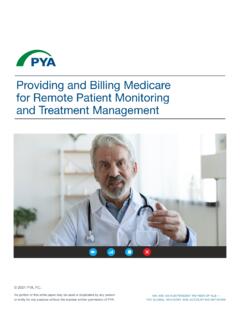Transcription of Closing a Healthcare Practice - MedPro
1 Guideline Title Closing a Healthcare Practice : Strategies and Risk management Considerations This document does not constitute legal or medical advice and should not be construed as rules or establishing a standard of care. Because the facts applicable to your situation may vary, or the laws applicable in your jurisdiction may differ, please contact your attorney or other professional advisors if you have any questions related to your legal or medical obligations or rights, state or federal laws, contract interpretation, or other legal questions. MedPro Group is the marketing name used to refer to the insurance operations of The Medical Protective Company, Princeton Insurance Company, PLICO, Inc.
2 And MedPro RRG Risk Retention Group. All insurance products are underwritten and administered by these and other Berkshire Hathaway affiliates, including National Fire & Marine Insurance Company. Product availability is based upon business and/or regulatory approval and may differ among companies. 2022 MedPro Group Inc. All rights reserved. Contents Introduction .. 1 Objectives .. 1 Planned Closures .. 1 Business Processes .. 2 Communication .. 3 3 Patients .. 3 Professional Organizations and Regulatory Agencies .. 4 Unplanned Closures .. 5 Notification Letters .. 6 Patients .. 6 Professional Organizations.
3 7 Disposition of Paper and Electronic Health Records .. 7 Record Maintenance and Retention .. 8 Special Considerations for Electronic Health Records .. 9 Record Storage .. 9 Record Destruction .. 10 Disposition of Other Practice Records .. 10 Conclusion .. 11 Resources .. 11 Endnotes .. 12 Appendix A. Sample Patient Notification Letter .. 13 Appendix B. Sample Patient Notification Letter .. 14 Guideline: Closing a Healthcare Practice : Strategies and Risk management Considerations 1 Introduction A Healthcare provider may close a Practice for a variety of reasons, such as retirement, relocation, career change, sale of the Practice , illness, or death.
4 Regardless of the precipitating factor, a process for orderly closure helps (a) provide continuity in patient care and appropriate management of patients health information, (b) protect the provider from potential liability and litigation, (c) ensure the capture of earned income and payment of outstanding debts, and (d) assist staff in transitioning to new employment. Objectives The objectives of this guideline are to: Provide an overview of considerations for both planned and unplanned Practice closures Offer guidance and standards for developing closure notification letters Discuss key components and processes related to the disposition of patient records, including both electronic health records (EHRs) and paper records Offer risk strategies and recommendations to help Healthcare providers establish smooth and efficient closure plans Planned Closures If a Practice closure is planned, preparation ideally should start a minimum of 12 months in advance or as soon as reasonably possible.
5 The Practice should develop an exit strategy and consider utilizing the services of a management consultant, an accountant, and an attorney. Additionally, regulations and guidance from state licensing entities can provide exit strategies, which can serve as a roadmap in the months leading up to the closure. Risk Tip An integral part of the closure process is consulting with state licensing entities ( , medical or dental boards) to identify any state-specific closure regulations, such as standards for notifying patients. Guideline: Closing a Healthcare Practice : Strategies and Risk management Considerations 2 Business Processes When Closing a Practice , special attention should be given to all tax-related issues, including payroll taxes.
6 All tax returns, documentation ledgers, and accounting records should be maintained in accordance with state and federal requirements. Additionally, 1 year prior to the planned date of closure, contracts and leases should be reviewed. These documents may include managed care contracts, answering service contracts, facility leases, maintenance contracts, office cleaning agreements, hazardous waste disposal contracts, etc. The review also should include third-party payer relationships, patient collections, and determinations as to how mail will be forwarded. The Practice s professional liability coverage also should be reviewed to identify any notice requirement for terminating coverage and any requirement to purchase or earn tail coverage (if the provider has a claims-made policy).
7 Tail coverage protects providers against all claims arising from professional services performed while the claims-made policy was in effect but reported after termination of the policy. If the provider is planning to Practice on a part-time basis, they should maintain professional liability coverage but discuss possible rate and classification changes with the professional liability company. If the practitioner is planning to do volunteer work that involves the provision of medical or dental care, they should check to see whether such work is covered by Good Samaritan laws or whether professional liability coverage is still required.
8 Medical supplies and medications require consideration as well. For medical supplies and stock medications, the Practice should check with its local vendor about returning unused, unopened, and unexpired items. For sample medications and vouchers, ask drug representatives about returning any unused items. States may have additional controlled substance requirements and other mandates for noncontrolled pharmaceuticals relative to termination or relocation of a Healthcare Practice . For Risk Tip If a Healthcare provider is planning to buy or sell a Practice , it is advisable to conduct the purchase or sale through a broker or attorney to ensure due diligence of business processes.
9 Guideline: Closing a Healthcare Practice : Strategies and Risk management Considerations 3 more information, providers should check the controlled substances reporting system and board of pharmacy for the state(s) in which they Practice . Any blank prescription pads should be destroyed when the Practice is closed. Communication Staff Staff should receive adequate notice about the intended closure. They should be told why the Practice is Closing , and their service and loyalty should be formally noted. Additionally, the provider should develop planned responses that staff can use to communicate with patients about the closure.
10 Patients Patient well-being should be a primary concern when a Practice is Closing , and ample written and verbal notice of the scheduled closure should be provided within a reasonable timeframe. Below are recommendations for communicating the closure to patients: Within 6 months of Closing , post announcements throughout the office(s) to inform current patients of the impending closure. Staff can reinforce this message by informing patients when they call and come in for appointments. Billing announcements and patient education handouts also can help reinforce the message. Within 90 days of Closing , place a brief announcement in local newspapers and on the Practice s website and social media sites.

